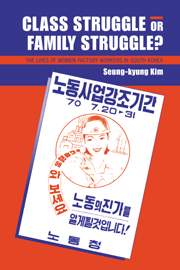Book contents
- Frontmatter
- Contents
- List of Tables and Figures
- Preface: Field, Subject, Author
- Acknowledgments
- Language Note
- 1 Women Caught between Global Capitalism and South Korean Patriarchy
- 2 The Process of Production in the Masan Free Export Zone
- 3 The Myth of Social Mobility: Its Creation and Reproduction among Women Workers
- 4 Labor Militancy and Collective Action
- 5 The Making of Working-Class Identity: Students' Theories and Workers' Lives
- 6 Conclusion
- References
- Index
2 - The Process of Production in the Masan Free Export Zone
Published online by Cambridge University Press: 02 December 2009
- Frontmatter
- Contents
- List of Tables and Figures
- Preface: Field, Subject, Author
- Acknowledgments
- Language Note
- 1 Women Caught between Global Capitalism and South Korean Patriarchy
- 2 The Process of Production in the Masan Free Export Zone
- 3 The Myth of Social Mobility: Its Creation and Reproduction among Women Workers
- 4 Labor Militancy and Collective Action
- 5 The Making of Working-Class Identity: Students' Theories and Workers' Lives
- 6 Conclusion
- References
- Index
Summary
From its inception, the Masan Free Export Zone (MAFEZ) has been a leading center of South Korean light industry and a major employer of young women in South Kyŏngsang Province. The cheap labor of young single women has been essential to the success of the Zone and its enterprises. This chapter looks at the process of production in the factories of MAFEZ, and the ways in which the workforce was controlled and manipulated to reach high levels of productivity. I begin by describing the Zone and the alliance between the South Korean government and foreign capital that led to its formation. Next, based on my survey of more than 700 women workers, I examine the background of the workforce employed in the zone: Who are they, and how do they come to be factory workers? Finally, I draw on my own experience in working at KTE, a large MAFEZ electronics company, and on extensive interviews with workers to consider the manufacturing process in the Zone's factories: How are women workers used and controlled by their employers? By examining the process of production, I lay the foundation for a deeper understanding of how women are caught between global capitalism and South Korean patriarchy.
MASAN CITY
The Free Export Zone
Masan is a port city located on the southeastern coast of Korea, only a short distance by sea from Japan. It was already a minor manufacturing center in 1970, when it was selected as the site for the larger and more important of two Free Export Zones to be established as part of the national program of exportled industrialization. Initially, MAFEZ was extremely attractive to foreign investors, and by 1975, 101 companies were operating factories there.
- Type
- Chapter
- Information
- Class Struggle or Family Struggle?The Lives of Women Factory Workers in South Korea, pp. 19 - 56Publisher: Cambridge University PressPrint publication year: 1997



